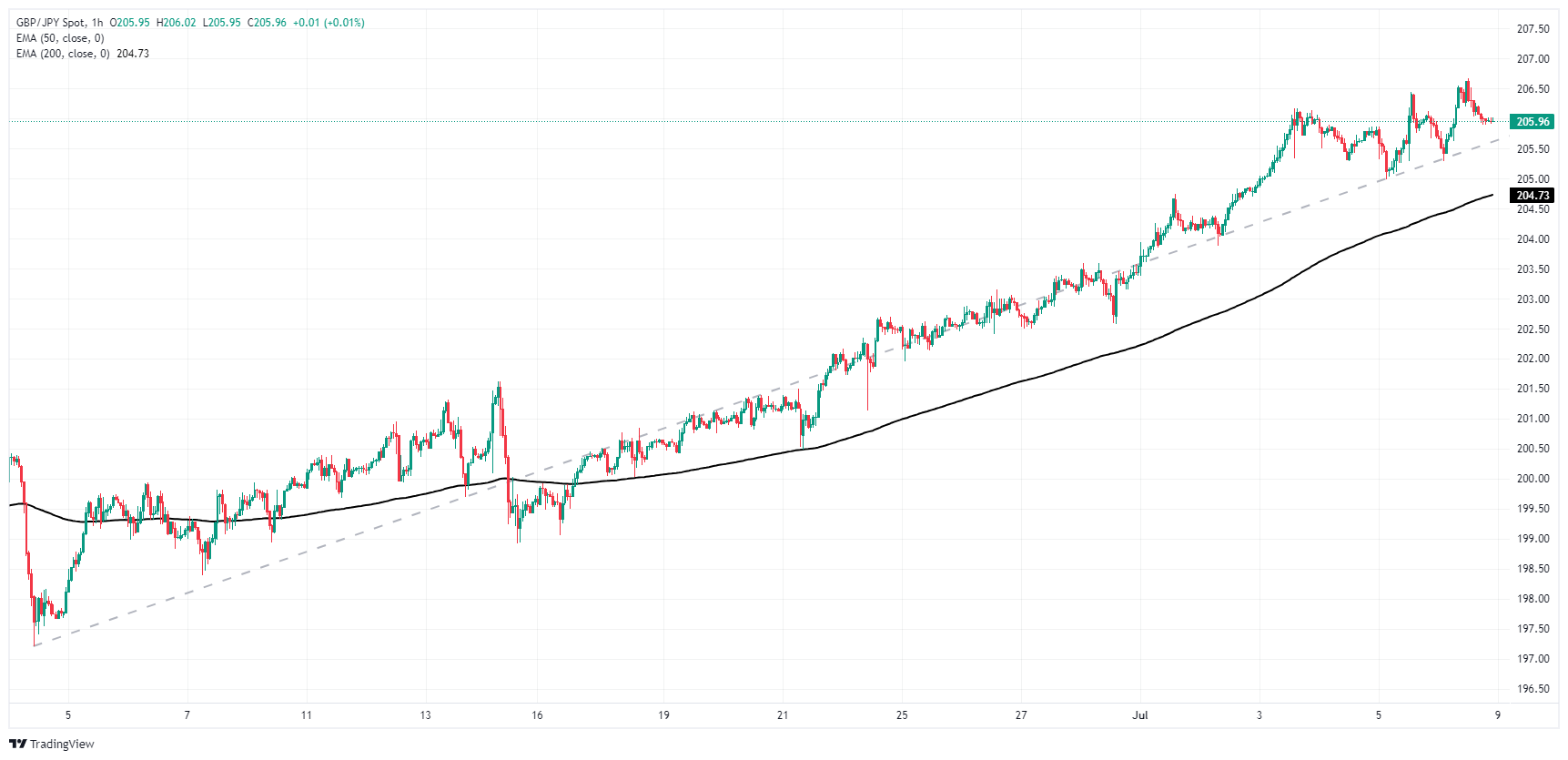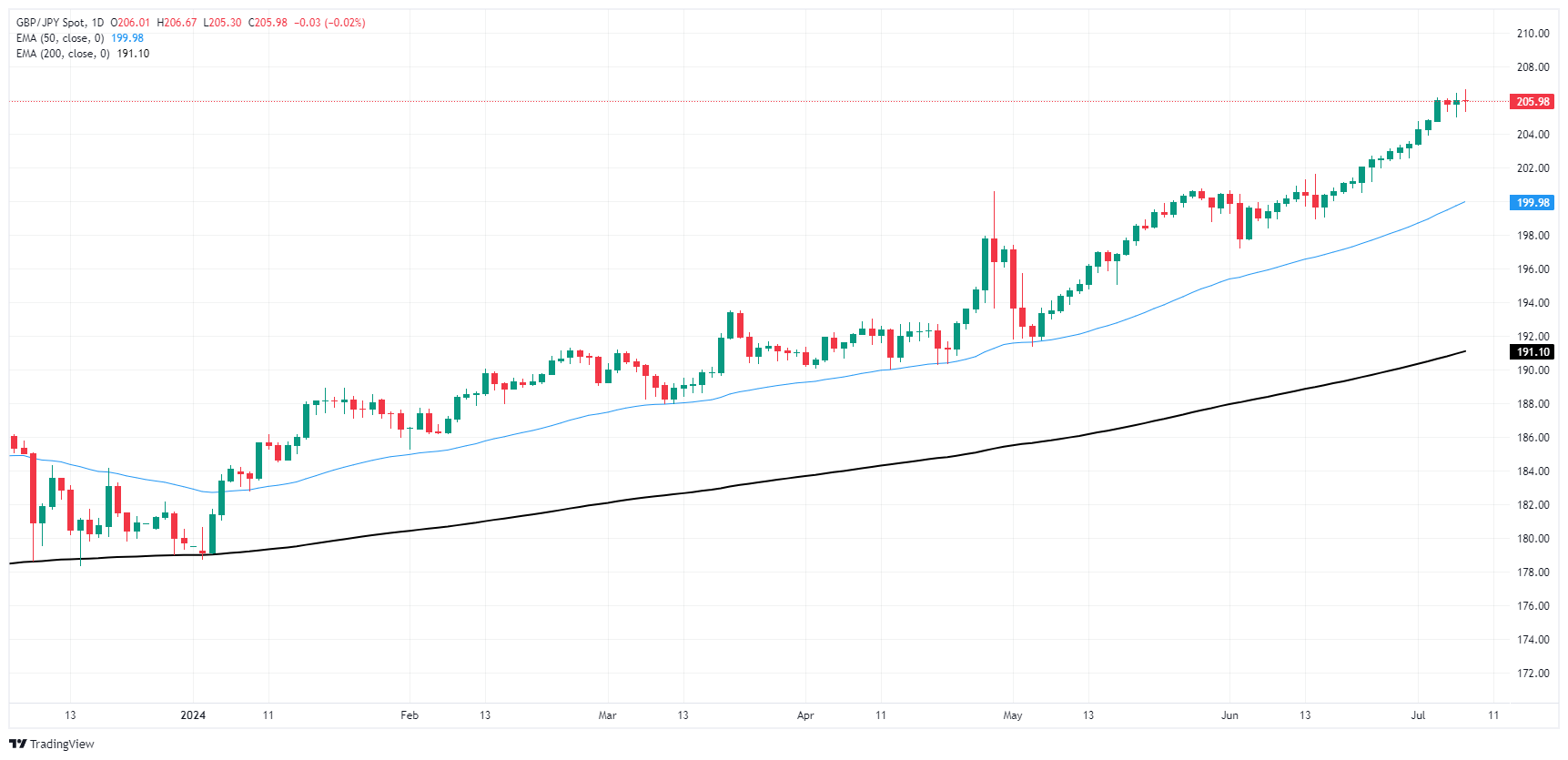GBP/JPY briefly tests fresh 16-year highs before pulling into the midrange
- GBP/JPY found yet another new 16-year peak, but momentum is slumping.
- Strictly mid-tier data is on the economic calendar for the Guppy this week.
- GBP/JPY continues to grind out fresh peaks, but topping patterns are growing.
GBP/JPY briefly tested a fresh 16-year peak as the pair continues to grind out years-long high bids. The Guppy touched 206.67 before settling back into Monday’s opening range. Despite setting regular new highs in a one-sided trend, bullish momentum appears to be drying up as the pair begins to hesitate on the top end of a nearly seven-month bull run.
Economic data remains light for both the Pound Sterling (GBP) and the Japanese Yen (JPY) this week. Japanese Labor Cash Earnings, reported early on Monday, rose for the year ended in May, but less than expected. Wages grew 1.9% YoY versus the previous revised 1.6%, missing the forecast of 2.1%. Little else of note remains on the data docket this week for the Yen, leaving JPY traders to struggle at the bottom of a long slide in the currency at the hands of a wide rate differential between the JPY and other major global currencies.
UK data also remains limited this week, with various appearances from Bank of England (BoE) policymakers slated for Wednesday and industrial and manufacturing activity survey results on the books for Thursday.
GBP/JPY technical outlook
GBP/JPY fell away from fresh 16-year highs above 206.50 set on Monday, settling back into familiar intraday territory at the 206.00 handle. Technical pressure is still firmly pinned into the bullish side, but topside momentum is showing signs of petering out, and progress in swing highs is slowly rapidly as bidders run out of gas.
Spinning top daily candles are getting priced into the Guppy charts, and traders should be on the lookout for a retreat to the 50-day Exponential Moving Average (EMA) near 200.00. Despite odds of a near-term pullback, the long-term trend heavily favors the bulls, and a rebound from major technical levels could be on the cards looking forward.
GBP/JPY hourly chart
GBP/JPY daily chart
Pound Sterling FAQs
The Pound Sterling (GBP) is the oldest currency in the world (886 AD) and the official currency of the United Kingdom. It is the fourth most traded unit for foreign exchange (FX) in the world, accounting for 12% of all transactions, averaging $630 billion a day, according to 2022 data. Its key trading pairs are GBP/USD, aka ‘Cable’, which accounts for 11% of FX, GBP/JPY, or the ‘Dragon’ as it is known by traders (3%), and EUR/GBP (2%). The Pound Sterling is issued by the Bank of England (BoE).
The single most important factor influencing the value of the Pound Sterling is monetary policy decided by the Bank of England. The BoE bases its decisions on whether it has achieved its primary goal of “price stability” – a steady inflation rate of around 2%. Its primary tool for achieving this is the adjustment of interest rates. When inflation is too high, the BoE will try to rein it in by raising interest rates, making it more expensive for people and businesses to access credit. This is generally positive for GBP, as higher interest rates make the UK a more attractive place for global investors to park their money. When inflation falls too low it is a sign economic growth is slowing. In this scenario, the BoE will consider lowering interest rates to cheapen credit so businesses will borrow more to invest in growth-generating projects.
Data releases gauge the health of the economy and can impact the value of the Pound Sterling. Indicators such as GDP, Manufacturing and Services PMIs, and employment can all influence the direction of the GBP. A strong economy is good for Sterling. Not only does it attract more foreign investment but it may encourage the BoE to put up interest rates, which will directly strengthen GBP. Otherwise, if economic data is weak, the Pound Sterling is likely to fall.
Another significant data release for the Pound Sterling is the Trade Balance. This indicator measures the difference between what a country earns from its exports and what it spends on imports over a given period. If a country produces highly sought-after exports, its currency will benefit purely from the extra demand created from foreign buyers seeking to purchase these goods. Therefore, a positive net Trade Balance strengthens a currency and vice versa for a negative balance.